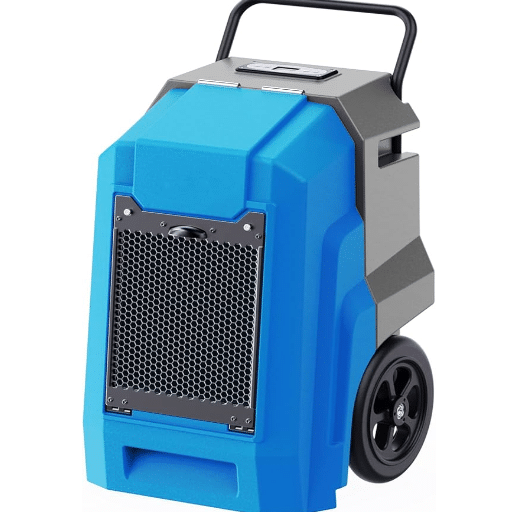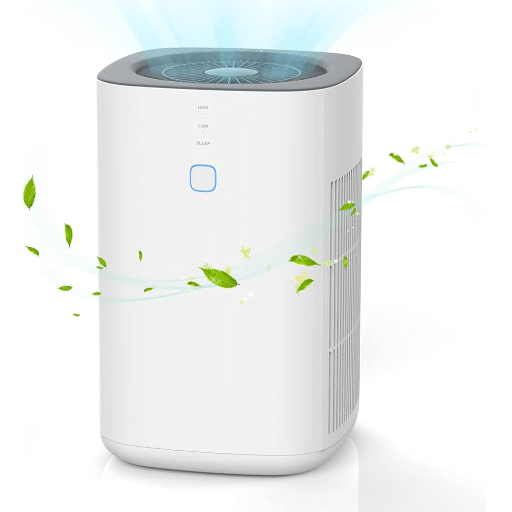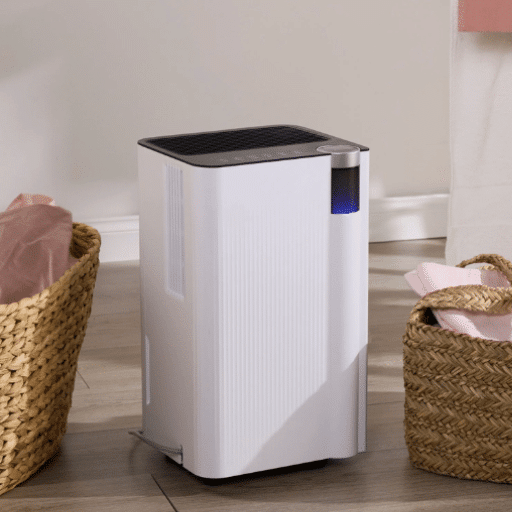The presence of excess humidity in the basement may result in a variety of problems such as mold growth, structural damage, or damp odors. It is important to understand the function of a dehumidifier, its place within an HVAC system, and how it works so that one may effectively approach these problems. This blog post will concentrate on the inner workings of a dehumidifier, its necessity for areas of high moisture concentration, such as basements, and its integration with the HVAC system to promote a healthier and more comfortable home. After reading this post, you will know how to efficiently manage the humidity in your basement and take care of your living space.
What is a Dehumidifier and How Does it Work?
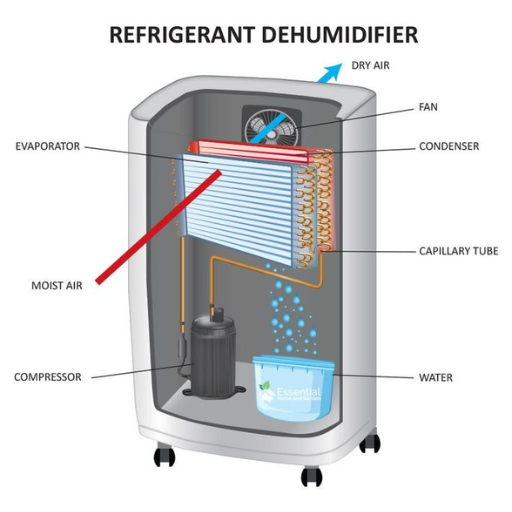
A dehumidifier is a mechanical device used to extract moisture from a specific area or space. A dehumidifier draws in moist air and cools it until fresh water vapor condenses into liquid and then reheats it before releasing it back to space. The removed water may be kept in a detachable bottle or waste bin. A dehumidifier functions by controlling humidity which in turn suppresses mold formation, decreases musty scents, and aids in improving air quality. This makes dehumidifiers of great importance to areas liable to moisture like basements.
How Does a Dehumidifier Work?
A dehumidifier extracts excess moisture from the air to keep humidity within ideal levels. It begins with a fan pulling in warm, moist air which is then cooled by passing over evaporator coils. Warmed air is dried further by reheating in warm coils. The water from dehydrators can be stored in a tank or freely drained through a hose. In areas with high humidity, dehumidifiers play an important role in improving air quality and preventing mold growth, thus helping allergic conditions.
What Are the Key Components Inside the Dehumidifier?
The essential parts of a dehumidifier are the compressor which runs the refrigeration cycle, the evaporator coils with a fan blowing air, and other components. Water is also stored in a reservoir tank or drainage. Some dehumidifiers are fitted with an air filter and sensor which helps enhance air quality while measuring humidity and moisture levels, ensuring optimal performance for accurate moisture extraction and control.
How Does a Dehumidifier Remove Moisture from the Air?
Dehumidifiers extract water from the air using a simple technique of drawing in damp air, chilling it, and collecting the resulting condensation. It begins with a fan sucking in warm, moist air. This air is then passed over evaporator coils that are cooled by a refrigeration unit. The air cools and in the process, the moisture condenses into water droplets. These water droplets are collected in a reservoir or drained through a hose. The dehumidified air is then passed over condenser coils where it is reheated before being released back into the room.
Dehumidifiers include:
- Moisture Removal Capacity: Standard residential units can remove from 20 to 70 pints of water per day, depending on the unit’s design and size. Typically measured in pints per day (pp).
- Coverage Area: This refers to dehumidifiers designated for specific room sizes, which usually start at 200 sq. ft for small units, and go beyond 4,500 sq. ft for bigger models.
- Humidity Range: This feature is customizable for most dehumidifiers with the user being able to set a target relative humidity level, typically between 30%, and 50%, based on comfort levels.
- Tank Capacity: The water tanks of these devices can hold anywhere between 1-4 gallons, although some larger units offer gaps in the tank for continuous drainage to avoid repetitive emptying.
- Energy Efficiency: Always search for the Energy Star certificate to see if a unit is operating efficiently and keeping energy costs low.
These factors combine to provide proper and efficient moisture removal for comfortable indoor climate conditions.
Why Use a Dehumidifier?
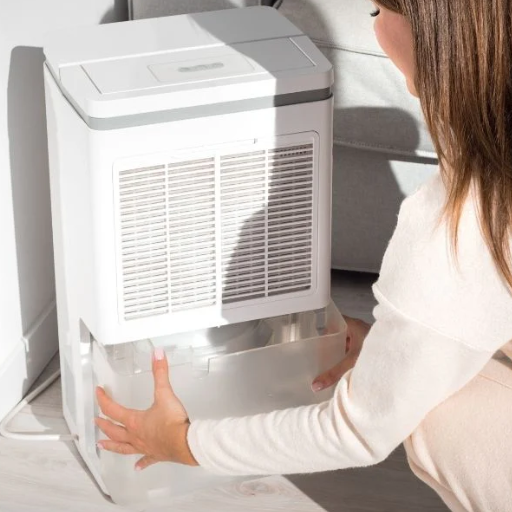
Using a dehumidifier helps maintain the comfort and quality of indoor air. It protects the health of residents and guards the home against damage that can be caused by excessive humidity. Dehumidifiers are useful in preventing mold formation, wood warping, and peeling paint, as well as resolving matters concerning breathing problems. Keeping the humidity at bay also contributes to the comfort of people living in moist areas by relieving musty scents and making the air more breathable. Furthermore, dehumidifiers protect furniture, electronics, and the structure of the home from damage due to moisture accumulation, thus prolonging the lifespan of these goods. Overall, using a dehumidifier will help save on repair costs all while creating a safer and healthier indoor environment.
What Are the Benefits of Using a Dehumidifier?
Personally, using a dehumidifier has improved my quality of life. My personal space now feels fresher due to a decline in indoor humidity. Dust mite populations and mold growth are now kept under control which means a healthier living space for me free from asthma or respiratory issue triggers. Damage mitigated to the walls, electronics, furniture, and appliances from moisture overload has been very helpful to me financially. To sum it up, maintaining comfort and increasing the value of my property is now very easy with this device. The user-friendly design makes it possible for anyone to operate the device with ease.
How Can a Dehumidifier Help with Mold and Mildew?
Using a dehumidifier helps with stopping mold and mildew formations by lowering moisture levels in the air, which serves as fungi food when growing. The fungus usually appears in places with a humidity level above 60%, a dehumidifier helps by maintaining the indoor humidity level at 30-50%, which greatly hinders termitic growth. Also, it assists in drying the moist parts of the house like the basement, bathrooms, and laundry room, further stopping the spores from infesting and reproducing. When a dehumidifier is used, moisture is greatly limited, which stunts new mold growth while slowing the spreading of the existing mold, fostering a healthier, mold-free environment.
How Does Indoor Humidity Affect Your Home?
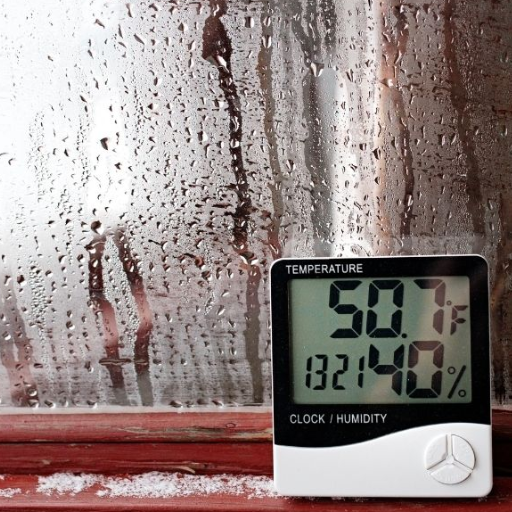
The health and comfort of a home are greatly determined by the indoor humidity level. An excess of moisture nurtures the growth of molds and mildews which destroys walls, damage ceilings, and furniture, and poses health risks. The sheer amount of moisture can also lead to the deformation of wood, paint blisters, and rusting of metal surfaces, which impacts the durability of the home’s construction materials. Conversely, low humidity leads to cracking of wooden furniture and floors, discomfort due to dry skin, and irritated sinuses. To safeguard the house and improve one’s well-being, it is important to maintain a balanced indoor humidity.
What is Relative Humidity and Why Does it Matter?
Relative humidity expresses the amount of water vapor in the air relative to the maximum it can hold at a given temperature in percentage. It is crucial because it affects the quality of air inside a building, and impacts comfort and the condition of the house. High relative humidity creates a risk of mold formation and the growth of dust mites, which poses health dangers. On the other hand, low relative humidity leads to dry skin, and issues with the respiratory tract, and may result in damage to wooden structures in the house. Keeping relative humidity between 30 and 50% will make it possible to achieve a healthy and comfortable living space.
How Does High Humidity Create Problems?
Excessive humidity puts everyone at risk both nutritionally and medically. When relative humidity is over 60 percent, it makes a perfect environment for mold and mildew which can cause allergies, asthma, and even other forms of respiratory problems. Greatly humid conditions also aid dust mites, which are a common allergen, to palpably thrive. From a more structural perspective, a build-up of moisture can damage wooden structures by rotting or warping them, weaken persevered wallpaper, and cause paint to peel. Furthermore, elevated humidity levels may give the appearance of a heightened temperature in the room which brings about the increased demand for air conditioning. Relative indoor humidity levels should be in the region of 30 to 50 percent to remain problem-free. These problems can be alleviated with the help of dehumidifiers. Proper air conditioning and ventilation can also aid in regulating the temperature.
How Can a Dehumidifier Improve Indoor Air Quality?
By alleviating excess moisture, a dehumidifier enhances air quality by preventing mold, mildew, and dust mites, which are allergenic and respiratory problem microorganisms, from developing. By sustaining the indoor relative humidity value in the range of 30-50%, a dehumidifier promotes a healthier living environment. It also eradicates musty smells and preserves household properties, such as furniture and electronics, from damage caused by moisture. Important technical parameters are capacity in pints p/day, the size of the room, an energy efficiency ratio (EER) of not less than 1.5 for economical operation, and a built-in humidistat that offers accurate humidity measurement.
Choosing the Right Dehumidifier for Your Needs
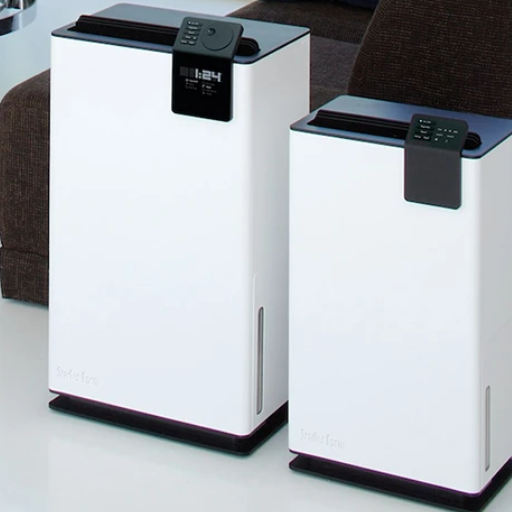
It is imperative to consider the room dimensions, humidity levels, and specific problematic areas when choosing a dehumidifier. Smaller areas like bedrooms or closets may only require a portable dehumidifier with lower capacity, while larger living areas may require a higher capacity unit. Choose a model with adjustable settings and a hygrometer that can measure and control moisture to address high humidity. You may also consider dehumidifiers with air filters as they improve the quality of air indoors by filtering out allergens and dust. Dehumidifiers should be economically efficient by evaluating their energy ratings. With these specifications, the household humidity levels can easily be regulated while improving air quality.
How to Determine the Right Size Dehumidifier for Your Space?
When I calculate the appropriate size of the dehumidifier for your space, I look at factors such as the square footage as well as the moisture level in the area. For small areas like bathrooms or closets, I choose a unit with a capacity of 10–20 pints. Dehumidifiers that hold 30–50 pints are appropriate for mid-sized rooms around 500 to 1,500 square feet. For large areas over 2,000 square feet, or simply very damp places like basements, I prefer the models that hold 60+ pints. My decision is always backed by the manufacturer’s recommendations and given the temperature and humidity in the room so that the unit can be effective for the space in question.
What Features Should You Look for in a Dehumidifier?
This guide walks you through selecting a dehumidifier that will best meet your individual needs without compromising efficiency; which can save you time and trouble later. Settable humidity levels allow you to choose the moisture level you need, while full tank and shut-off notifications guarantee overflowing tanks are a thing of the past. Awarded with an Energy Star certification, these models will keep your bills down while remaining energy efficient. For larger units, an installed pump or drainage system will make water removal much easier. Dehumidifiers with efficient quiet mode operation are ideal for living spaces or bedrooms, while portable units with handles or wheels are easier to move around from one room to another. Ensure your dehumidifier features air filters that capture dust and allergens to improve the overall quality of the air in the room.
Maintenance and Care for Your Dehumidifier

To properly maintain your dehumidifier, begin by cleaning and changing the air filter regularly to enhance air quality and airflow. If using a water collection bucket, remember to empty it regularly; otherwise, inspect the drainage hose for clogs if using a continuous drain option. Maintain external surfaces by wiping down the dehumidifier regularly, and prevent dust accumulation by cleaning the coils periodically. Follow the manufacturer’s manual regarding specific maintenance guidelines, and when the unit is not in use, store it in a dry location.
How to Determine the Right Size Dehumidifier for Your Space?
Dehumidifiers should be selected according to the rooms’ square footage and moisture content level. A small room will usually be served well by a 20- to 30-pint unit, while larger spaces, or extremely humid rooms, might require a 50-pint or higher model to control humidity effectively.
What Features Should You Look for in a Dehumidifier?
For ease of use, consider the convenience features of adjustable humidity levels, a built-in hygrometer, and an automatic shutoff. For more efficiency and cost-effectiveness in the long run, additional filters and energy efficiency certifications will enhance functionality.
How Often Should You Empty the Water Tank?
The interval for emptying the water tank is determined by the dimensions of the tank, the dehumidifier’s output, and the humidity levels in the area. In a moderately damp environment, most residential dehumidifiers should have their tanks emptied once or twice per day. Smaller tanks (1-2 gallons) will require frequent emptying in highly humid conditions, whereas larger ones (4-5 gallons) are less maintenance-heavy. For manual emptying to be reduced, opt for models with a continuous drain or pump feature for automated water removal. These pumps do not require manual action to function. The performance of the apparatus greatly depends on regular monitoring.
What Are the Best Practices for Dehumidifier Maintenance?
Maintaining your dehumidifier properly will greatly increase its lasting effectiveness and efficiency. Remember to follow the guidelines below.
- Clean or Replace the Filter Regularly
Most dehumidifiers have air filters that capture dust and or allergens. Follow the manufacturer’s recommendations on cleaning or replacing the filters, typically every one to three months, to ensure proper airflow and performance.
- Empty and Clean the Water Tank Frequently
To avoid. Prevent mold or bacterial growth by regularly emptying and cleaning the water tank. Use warm soapy water, and make sure the tank is completely dry before putting it back in the unit.
- Inspect and Clean the Coils
Non-cleaned or heavily dirty coils may run the risk of lowering system efficiency. It would be best to unplug the unit and clean the coils with a soft brush or cloth. Make sure the unit has the proper temperature so it doesn’t frost over.
- Check the Continuous Drain or Hose Connection
If your system has the option of continuous drain, always check out the hose for clogs or leaks to ensure smooth dehumidifier operation.
- Ensure Proper Placement
Put the dehumidifier where there is smooth air circulation and away from walls to avoid getting obstructed. This greatly improves the unit’s antiwear features.
When observing these recommendations, your dehumidifier will remain in its optimal condition and will therefore continuously and efficiently control the humidity levels in your area. Regular maintenance also helps prevent expensive repairs and increases the life of the device.
How Can Proper Maintenance Prevent Water Damage?
To avert moisture problems, the dehumidifier requires attention. Performing cleaning and maintenance procedures on the water tank, coils, and hose connections guarantees that the unit runs efficiently, avoiding leaks, clogs, or other pooling issues. Proper placement and airflow troubleshooting assist in averting condensation problems that could otherwise seep into structures like walls or floors. By attending to these maintenance procedures, the possibility of mold growth, structural damage, or unhealthy humidity levels is mitigated, protecting your home’s integrity as well as indoor air quality.
References
Frequently Asked Questions (FAQ)
Q: What is a dehumidifier and how does it work?
A: A dehumidifier is an appliance that helps reduce moisture in the air inside your home. It works by drawing in warm air, cooling it to condense the moisture, and then releasing the drier air back into the room. This process can help make your home feel less muggy and prevent mold and dust.
Q: What are the different types of dehumidifiers available?
A: There are two main types of dehumidifiers: refrigerant and desiccant. Refrigerant dehumidifiers cool the air to remove moisture, while desiccant dehumidifiers use a moisture-absorbing material to dehumidify the air. Both types are effective but serve different needs based on the environment.
Q: How does a whole-home dehumidifier differ from a portable one?
A: A whole-home dehumidifier is integrated into your HVAC system to dehumidify the entire house, while a portable dehumidifier is designed for individual rooms or specific areas like basements. Whole-house dehumidifiers are more efficient for larger spaces.
Q: Why might I need a dehumidifier in my basement?
A: Basements often have higher humidity levels due to limited ventilation and proximity to the ground, making them prone to condensation. A dehumidifier can help reduce moisture in your home, prevent musty odors, and protect against mold and mildew.
Q: Can an air conditioner serve as a dehumidifier?
A: While an air conditioner can cool the air and remove some moisture, it is not as effective as a dedicated dehumidifier. Air conditioning units primarily aim to cool the air rather than dehumidify it, so a dehumidifier may be necessary in very humid environments.
Q: How do dehumidifiers help with home improvement?
A: Dehumidifiers can make your home more comfortable by reducing excess moisture, which protects your property from water damage, mold, and dust. This improvement in air quality can also enhance the longevity of your home’s structure and furnishings.
Q: What maintenance does a dehumidifier require?
A: Regular maintenance for a dehumidifier includes cleaning or replacing filters, emptying the water tank if it’s not self-draining, and ensuring the appliance is free of dust and debris. Proper maintenance ensures the dehumidifier operates efficiently and extends its lifespan.

